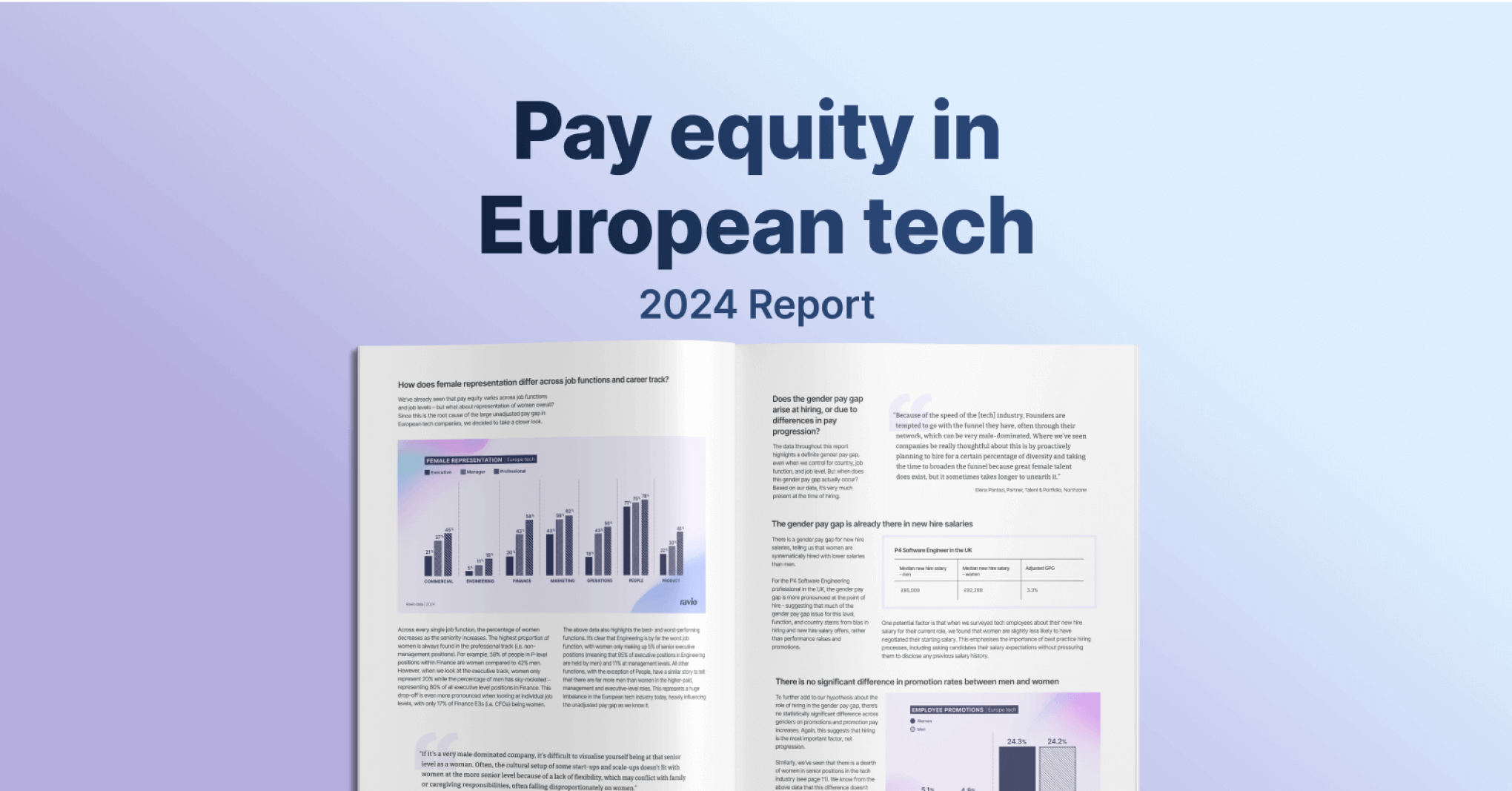- How do People leaders define fair pay?
- What progress have tech companies made to improve pay equity?
- What progress have tech companies made to improve pay transparency?
- What progress have tech companies made to improve gender representation?
- Is pay equity a true priority for businesses today?
- How do employees feel about pay equity in their company?
- Looking forward: how can European tech improve?
European tech’s unadjusted gender pay gap is 25%, that means the average woman in tech earns 25% less than the average man.
However, when we look at the gender pay gap as a like-for-like comparison between men and women doing equal work (known as the adjusted gender pay gap), then women earn 2.5% less than men.
Although companies are trending in the right direction, it’s clear that there’s still work to be done to balance out the gender scales – especially when it comes to pay equity and gender representation.
Worse still, with the EU Pay Transparency Directive coming into effect soon, there’s going to be increasing scrutiny on companies’ pay practices.
But one question remains: what are People leaders actually doing to address pay inequities?
We recently sent out a survey to over 250 People leaders to answer this question. You can find the results in our recent pay equity report, as well as right here, where we’ll be exploring what progress companies are making and how People leaders are prioritising pay equity in 2024.
How do People leaders define fair pay?
When we asked People leaders what they’re doing to ensure pay equity within their company, we found that 60% have made pay fairness a core principle within their compensation philosophy.
But do People leaders have the same definition of fair pay? Or are companies working towards different ideals?
Here’s how some of our People leader survey respondents define fair pay:
- “Employees earn approximately the same based on the value they add to the company – not basing it solely on tenure, years of experience etc.”
- “That all employees are paid according to the skills and experience they bring regardless of any protected characteristic.”
- “People are paid fairly for the job that they do – both inline with external market rates and with their colleagues internally. Salary bands should be used for employees to be rewarded salary increases as they gain experience and perform well.”
It’s clear that there are some differences in how People leaders think about fair pay.
Some feel it means paying employees based on the value they add to a company, focussing less on experience. Others might prefer to use external market data to understand what the value of that employee would be in the market, plus considering their level of experience.
With this spectrum of definitions in mind, let’s see what companies are doing to improve fair pay.
What progress have tech companies made to improve pay equity?
Improving pay equity in your organisation shouldn’t just relate to closing the salary gap.
Although it’s important, improving pay equity encompasses much more, including improving representation, ensuring you offer fair and equitable compensation, and improving communication and pay transparency within your organisation.
When we asked People leaders what measures their company has taken towards pay equity, we saw that the majority (60%) have included pay fairness as a core principle in their compensation philosophy.
Other top priorities included adjusting salaries to fix any pay disparities (48%), conducting a pay equity audit in order to understand existing pay disparities (47%), and using up-to-date salary benchmarks for data-backed compensation decisions (41%).
It’s clear that, once People leaders have made pay fairness core to their compensation strategy, they know they must be data-informed in their decision-making.
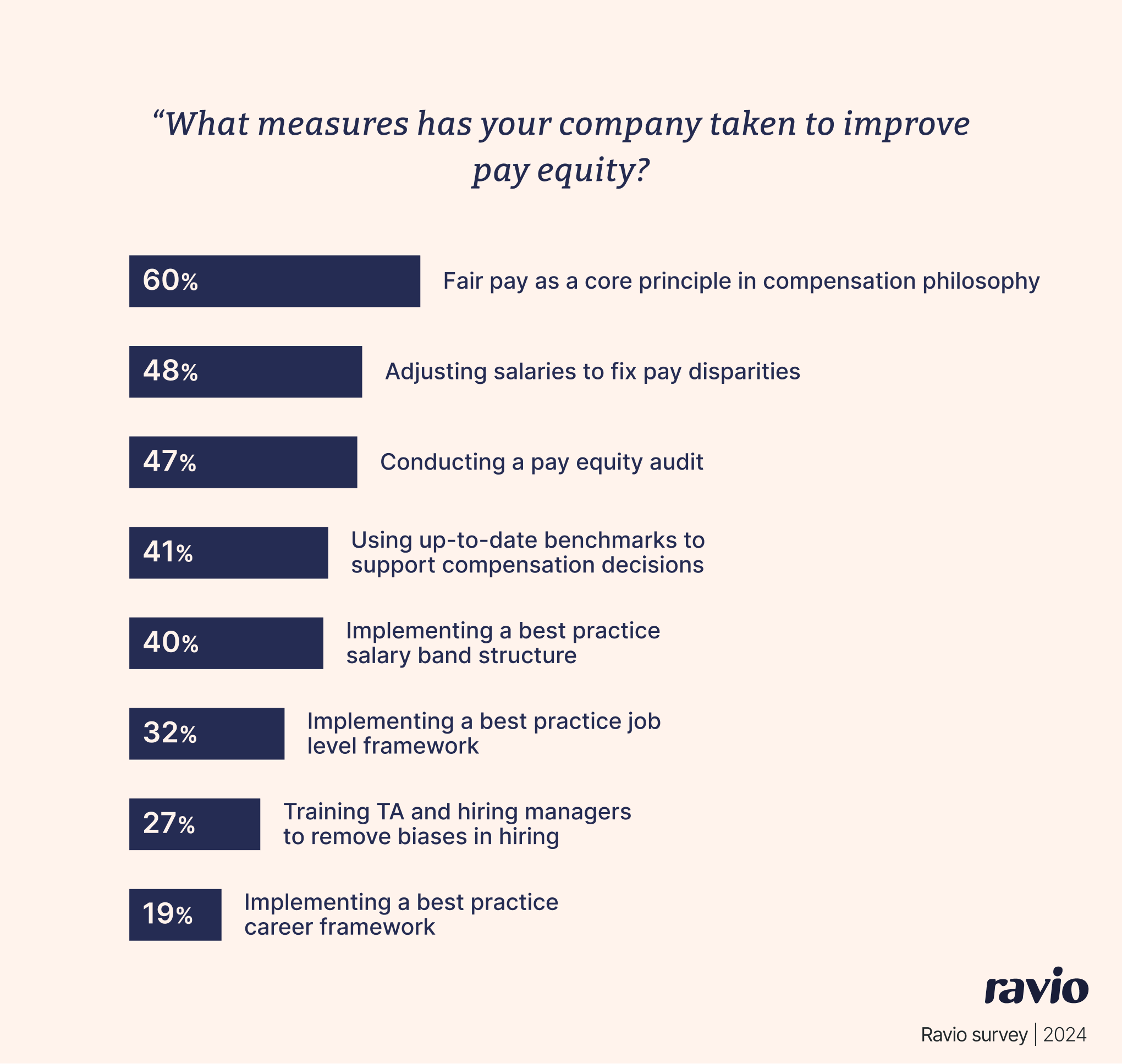
What progress have tech companies made to improve pay transparency?
Pay transparency differs from pay equity. Whilst pay equity relates to ensuring employees are paid fairly and equitably for their job role and responsibilities, pay transparency refers to providing clarity to employees about why they receive compensation of a certain value.
When we asked how People leaders planned on improving pay transparency in their organisation, results varied.
- Employees have access to the rationale behind our level framework, career frameworks, salary band structures etc – 31%
- Employees have access to actual salary band ranges across the company’s organisation structure – 31%
- Measured and published data on our gender pay gap to comply with legislation – 27%
- Employees have access to actual salaries across the organisation (full transparency) – 23%
- Removed salary expectation and history questions from the hiring process – 7%
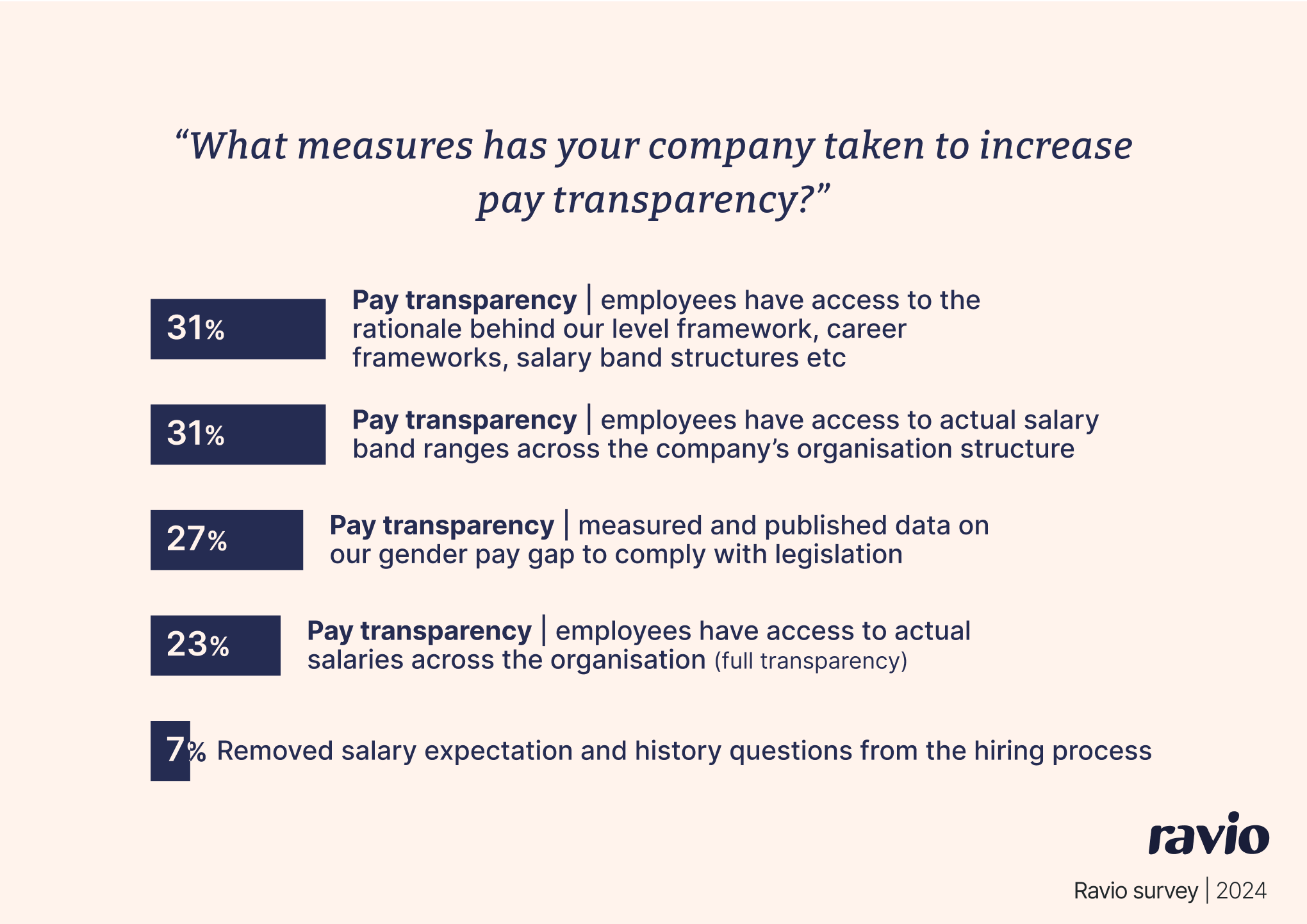
The least adopted measure by far is that only 7% of companies have stopped asking job candidates about their salary history or expectations. In a previous blog on the causes of the gender pay gap, we found that this is a key component of removing unconscious bias from hiring processes.
The most popular measure is to clearly communicate the company's compensation approach (job levels, salary bands, career progression pathways) to employees – though this is still only in place at a third of tech companies.
This is reflected in the experience of employees, too.
Only 26% of female employees say they have a good understanding of how their salary compares to male colleagues, just 26% of female employees have a good understanding of performance and salary review processes, and just 12% have a good understanding of career and pay progression for their role.
“When managers fail to openly discuss career progression or to uniformly present opportunities, it fuels a belief among women that their professional growth isn’t valued. This can undermine women's confidence and prevent them from exploring opportunities further up the career ladder.”

Chief Portfolio Talent Officer, Balderton Capital
What progress have tech companies made to improve gender representation?
When we asked People leaders if increasing the proportion of women across the team was a priority, the majority said yes – 78% of companies.
For the companies where increasing female representation is not a priority, responses focused on a lack of understanding in senior leadership or there being other, more important, business priorities currently – suggesting that executive buy-in could be a barrier to pay equity.
- “Executives and parent company do not think it is necessary or a priority.”
- “There’s a lack of knowledge and understanding which means it is not a priority in our company. We have no diversity policy.”
- “Because we are fundraising and that is the main focus at the moment.”
When we asked how People leaders planned on improving gender representation, a few main themes arose.
- Female employees are included in all interview panels – 61%
- Talent acquisition and hiring managers are trained on unconscious bias – 50%
- Flexibility on family responsibilities e.g. working hours, childcare support, generous parental leave policies – 49%
- At least one female executive or c-suite team member has been appointed – 46%
- A leader and management training scheme for women – 38%
- Blind recruitment to remove initial gender bias in hiring – 30%
- A mentorship scheme for women – 28%
- Involvement in education schemes e.g. staff members speaking in local schools about opportunities for women in tech – 28%
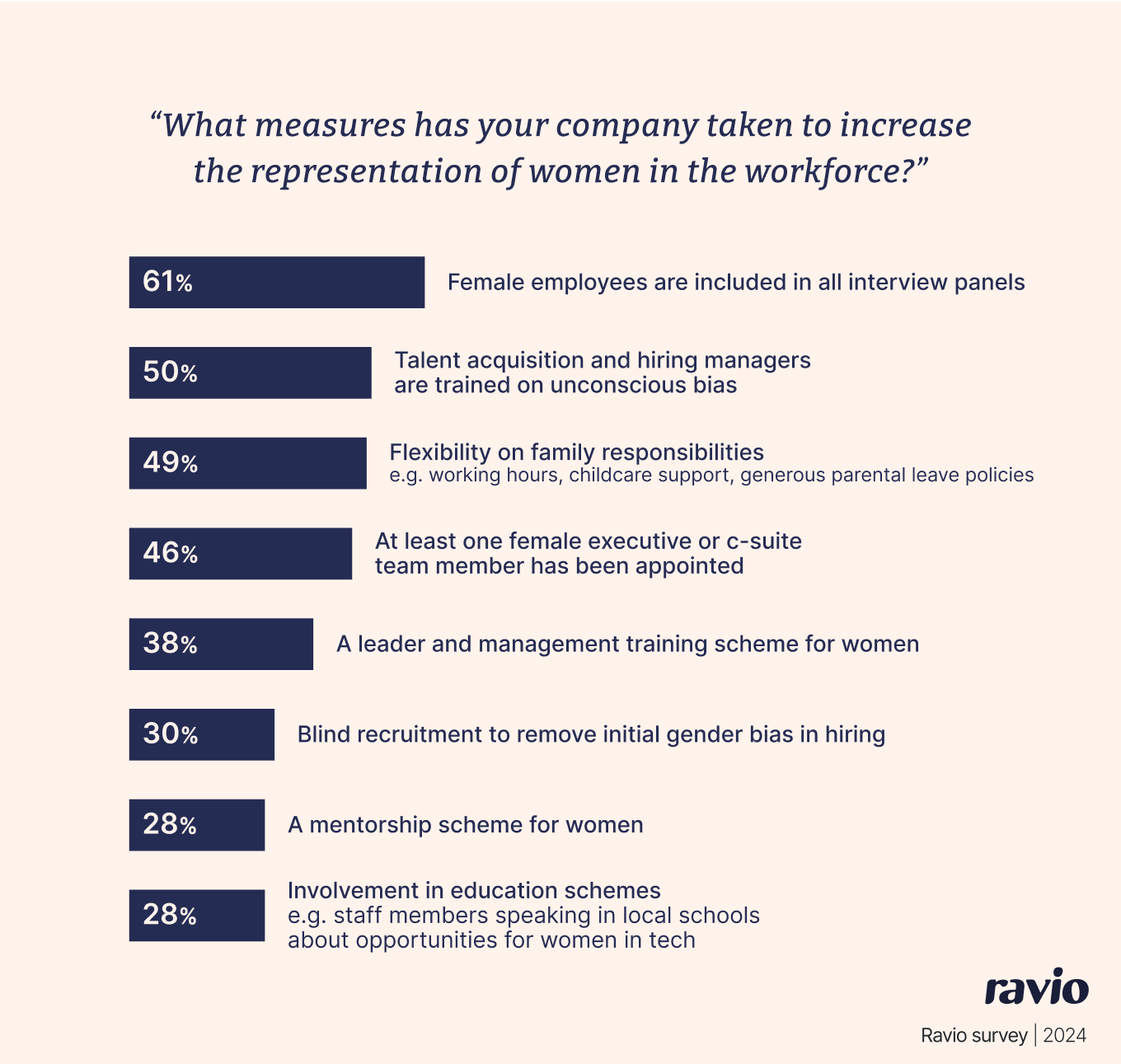
Supporting parental leave and addressing any issues in the hiring process are the most popular initiatives for companies looking to improve gender representation. 61% of companies are ensuring all interview panels include at least one female employee, and 50% train hiring managers on unconscious bias. Nearly half (49%) allow parents flexibility for family responsibilities.
We analysed the top 3 causes of the tech gender pay gap and identified that biases in the hiring process, a lack of female representation at senior levels, and the difficulties women face raising a family whilst trying to progress their career were key blockers to achieve pay equity.
It’s clear that some tech companies are focussing in the right places, but many can still be more intentional in how they adjust their hiring practices and parental leave policies.
Here’s what Elena Pantazi Read, Talent & Portfolio Partner at Northzone, had to say.
“Because of the speed of the tech industry, founders are tempted to go with the hiring funnel they have, often through their network, which can be very male-dominated. Where we’ve seen companies be really thoughtful about this is by proactively planning to hire for a certain percentage of diversity and taking the time to broaden the funnel because great female talent does exist, but it sometimes takes longer to unearth it.”

Partner, Talent & Portfolio, Northzone
Is pay equity a true priority for businesses today?
We’ve seen what People leaders are doing to improve pay equity, pay transparency and gender representation. But initiatives aside, are businesses actually prioritising pay equity and closing the gender pay gap?
When we asked People leaders whether pay equity is a priority in their company, 86% of People leaders said that it was compared to only 14% who said no.
This shows positive intent. For those companies that aren’t prioritising pay equity it comes down – once again – to senior leadership buy-in.
- “It’s hard to get executives to buy into HR programmes.”
- “Executives and our parent company do not think it’s an important priority.”
- “Because c-level management is male only.”
Given that, in the majority of companies, it is the CEO who owns pay equity, it makes sense that this would be the major blocker – getting executives to understand the value and importance of pay equity is crucial.
How do employees feel about pay equity in their company?
Employee perception matters. People leaders can make enormous strides in improving pay equity and representation, but if employees perceive reality differently, then you will still be fighting a losing battle.
Unfortunately, there is still a disconnect between what companies are doing and what employees feel. Despite 86% of People leaders making pay equity a priority, just over half of employees (54%) think eliminating the gender pay gap is a priority for their company.
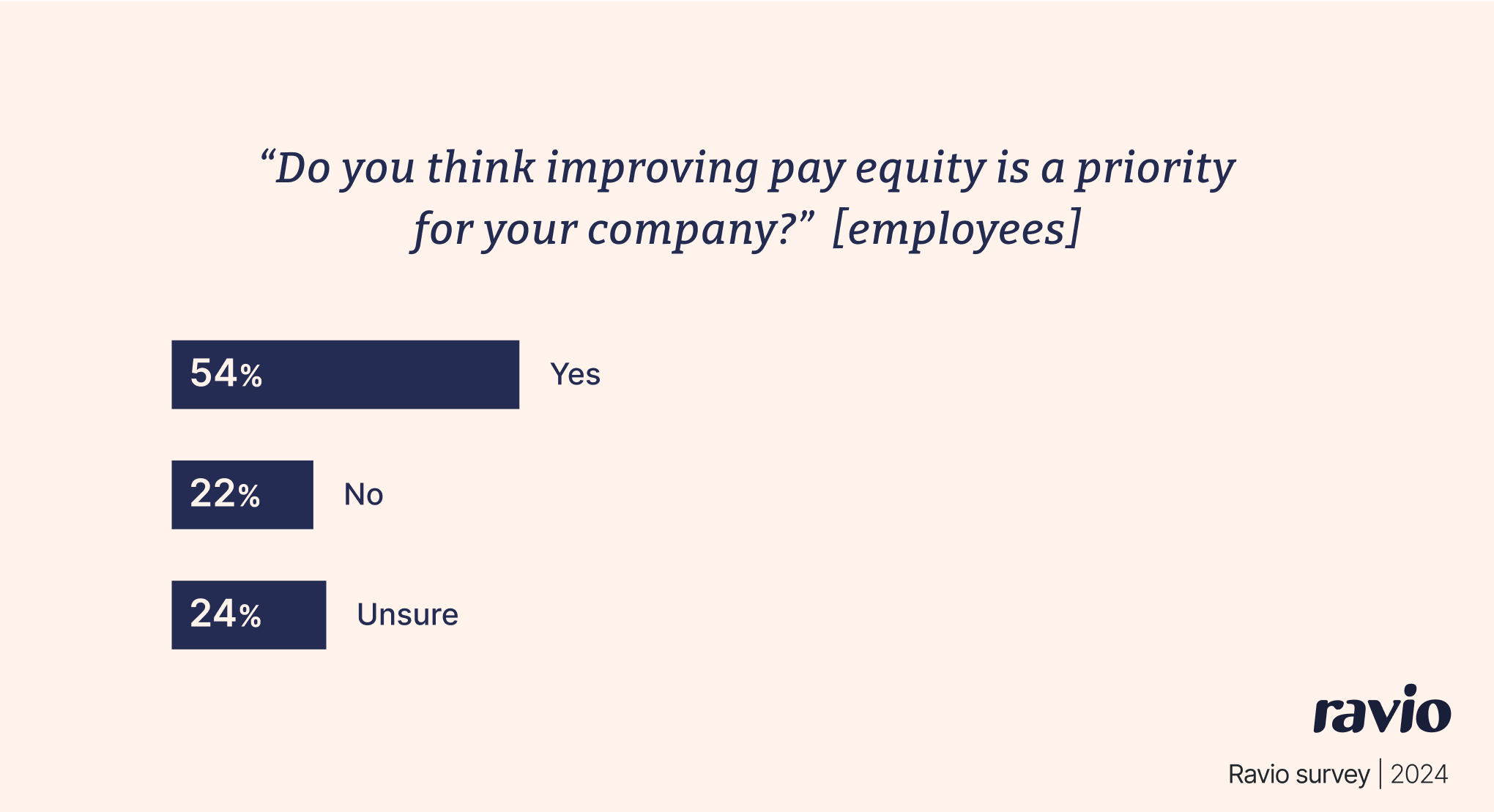
Companies must improve how they talk about pay equity and pay equity initiatives to their employees.
This can include using employee focus groups to stress-test your pay equity plans, detailing your pay equity initiatives to employees, and demonstrating where you are making progress in your pay equity metrics (and where you’re not too!).
Looking forward: how can European tech improve?
While it’s promising that the majority of People leaders are prioritising pay equity in 2024, a gap remains between leadership intentions and employee perceptions. Ravio's survey data shows that despite many initiatives, significant work is needed to bridge these disparities.
With the EU Pay Transparency Directive adding external pressure, internal efforts must focus on effective communication and education about pay policies and the importance of gender representation. Senior leadership's commitment is crucial to ensure these policies are understood and impactful.
For a detailed look at how businesses are tackling these challenges, download our comprehensive pay equity report here.
